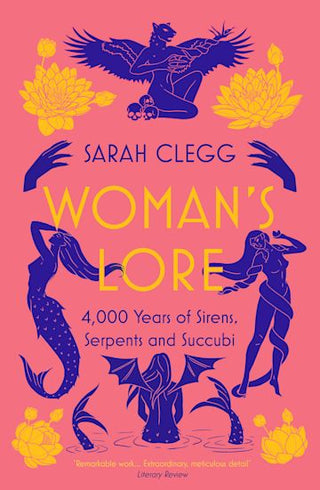-
The history of a demonic tradition that was stolen from women and then won back again.
Creatures like Lilith, the seductive first wife of Adam, and mermaids, who lured sailors to their death, are familiar figures in the genre of monstrous temptresses who use their charms to entice men to their doom.
But if we go back 4,000 years, the roots of these demons lie in horrific creatures like Lamashtu, a lion-headed Mesopotamian demon who strangled infants and murdered pregnant women, and Gello, a virgin ghost of ancient Greece who killed expectant mothers and babies out of jealousy. Far from enticing men into danger and destruction, these monsters were part of women-s ritual practices surrounding childbirth and pregnancy. So how did their mythology evolve into one focused on the seduction of men?
Sarah Clegg takes us on an absorbing and witty journey from ancient Mesopotamia to the present day, encountering a multitude of serpentine succubi, a child-eating wolf-monster of ancient Greece, the Queen of Sheba and a host of vampires. Clegg shows how these demons were appropriated by male-centred societies, before they were eventually recast as symbols of women-s liberation, offering new insights into attitudes towards womanhood, sexuality and women-s rights.
University Bookshop Limited (In Liquidation) is in liquidation from 2 July 2025 and will be trading during the start of Semester Two. During this time only stock on hand can be purchased. No special orders will be made. No credits or gift vouchers can be redeemed. No returns will be accepted
- Fiction
- Children's and Young Adults Fiction
- Classic Fiction
- Contemporary Fiction
- Crime Fiction
- Graphic Novels
- LGBTIQA+
- New Zealand Fiction
- Poetry
- Children's and Young Adults Fiction
- Children's and Young Adult Fiction
- Pasifika Children's and Young Adult Fiction
- Picture Books
- Māori Children's and Young Adult Fiction
- New Zealand Children's and Young Adult Fiction
- New Zealand Picture Books
- Contemporary Fiction
- Fantasy
- Historical Fiction
- Horror and Ghost Stories
- Science Fiction
- Short Stories
- New Zealand Fiction
- New Zealand Classic Fiction
- New Zealand Crime and Thrillers
- New Zealand Fantasy and Sci-Fi
- New Zealand Graphic Novels and Manga
- New Zealand Historical Fiction
- New Zealand Horror and Ghost Stories
- New Zealand Short Stories
- Non-Fiction
- Arts and Artists
- Business and Law
- Health and Wellness
- Humanities
- Language and Education
- Lifestyle Books
- Māori Studies Books
- New Zealand Non-Fiction
- Pasifika Books
- Reference
- Science and Technology
- Social Sciences
- LGBTIQA+ Non-Fiction
- Medicine
- Veterinary Medicine
- Nursing
- Arts and Artists
- Architecture
- Art and Artists
- Dance
- Design and Graphic Design
- Fashion
- Film Studies
- Media Studies
- Music
- Photography
- Theatre Studies
- Business and Law
- Accounting and Finance
- Business Communication Studies
- Business Information Systems
- Business Statistics
- Careers Advice
- Economics
- Entrepreneurship
- Human Resource Management
- International Business
- Investment
- Law
- Management
- New Zealand Business Studies
- New Zealand Law
- Tourism and Hospitality
- Health and Wellness
- Diet and Nutrition
- Health and Wellness
- Mind Body Spirit
- Self-help and Personal Development
- Humanities
- Ancient History
- Ancient Languages
- Anthropology and Archaeology
- Cultural Studies
- Disability Studies
- Environmental Studies
- Gender Studies
- History
- Museum Studies
- Philosophy
- Politics
- Religion and Spirituality
- Language and Education
- Education
- ESOL and ELT
- Language and Literacy
- Language Teaching and Learning
- Languages Chinese
- Languages French
- Languages German
- Languages Italian
- Languages Japanese
- Languages Korean
- Languages Spanish
- Library Studies
- Linguistics
- Literary Studies
- Lifestyle Books
- Biography and Memoirs
- Crafts and Hobbies
- Food and Drink
- Gardening
- Humour
- Popular Science
- Sport and Outdoor Recreation
- Travel Writing and Guides
- Māori Studies Books
- Disputed Land Whenua tautohetohe
- Māori Arts and Artists
- Māori Biography and Memoirs Haurongo
- Māori Crafts Mahi ā-ringa
- Māori Culture Mātauranga Māori
- Māori Education Mātauranga
- Māori Fiction and Poetry
- Māori Film and Media Studies
- Māori Food And Drink Kai me te inu
- Māori Health and Wellness Hauora
- Māori History Kōrero nehe
- Māori Indigenous Knowledge Mātauranga Māori
- Māori Mythology Pūrākau
- Māori Politics Tōrangapū
- Māori Religion Whakapono
- Matariki
- Te Reo Māori
- Treaty of Waitangi Tiriti o Waitangi
- New Zealand Non-Fiction
- New Zealand Architecture
- New Zealand Arts and Artists
- New Zealand Biography and Memoirs
- New Zealand Education
- New Zealand Environment and Sustainability
- New Zealand Film and Media Studies
- New Zealand Food and Drink
- New Zealand Gardening
- New Zealand Health and Wellness
- New Zealand History
- New Zealand Natural History
- New Zealand Photography
- New Zealand Politics
- New Zealand Social Services Welfare and Criminology
- New Zealand Sociology
- New Zealand Sport and Outdoors
- New Zealand Travel Writing and Guides
- Religion in New Zealand
- Pasifika Books
- Pacific Arts Crafts and Architecture
- Pacific Biography and Memoirs
- Pacific Culture and Indigenous Knowledge
- Pacific Education
- Pacific Fiction and Poetry
- Pacific Food and Drink
- Pacific Health and Wellness
- Pacific History and Politics
- Pacific Law
- Pacific Natural History
- Pacific Photography Film and Media Studies
- Reference
- Children's and Young Adult Reference
- Dictionaries
- General Reference
- Information Sciences
- New Zealand Children's Reference
- Research Methods
- Science and Technology
- Biology
- Chemistry
- Computing and IT
- Earth Science
- Engineering
- Maths
- Physics
- Trades
- Social Sciences
- Counselling and Therapy
- Psychology
- Social Services Welfare and Criminology
- Social Work
- Sociology
- Medicine
- Administration and Ethics
- Anaesthesiology
- Anatomy and Physiology
- Cardiology
- Clinical and Internal medicine
- Complementary Health
- Dentistry
- Dermatology
- Emergency medicine
- Endocrinology
- Family medicine
- Healthcare Research
- Immunology and Infectious Diseases
- Medical Genetics
- Medical Study Guides
- Neurodiversity
- Neurology
- Obstetrics and Gynecology
- Oncology
- Ophthalmology
- Orthopaedics
- Paediatrics
- Pain Medicine
- Paramedic Studies
- Pathology
- Pharmacology
- Physical medicine and rehabilitation
- Psychiatry and Mental Health
- Public Health Medicine
- Radiology
- Respiratory Medicine
- Sexual Health Medicine
- Speech and Language Disorders
- Sport and Exercise Medicine
- Surgery
- Trans and Non-binary Health
- Urology
- Nursing
- Community Nursing
- Critical Care Nursing
- Geriatric Nursing
- Medical Surgical Nursing
- Mental Health Nursing
- Midwifery
- Nurse Leadership and Education
- Nursing Fundamentals and Skills
- Nursing Pharmacology
- Nursing Study Guides
- Occupational Therapy
- Paediatric Nursing
- Palliatve Care Nursing
- Textbooks
- ACG
- AUT
- College of Natural Health and Homeopathy
- Northtec
- South Pacific College of Natural Medicine
- Speciality Trainees of New Zealand
- Toi Ohomai Institute of Technology
- Unitec Institute of Technology
- University of Auckland
- Wintec Languages
- Stationery & Gifts
- Pens
- Pencils
- Highlighters and Markers
- Exercise Books and Pads
- Planning and Revision
- Art and Craft
- Filing and Storage
- Maths Equipment
- Wrapping
- Gifts and Giftware
- Art and Craft
- Art Pads
- Drawing Supplies
- Glue
- Painting Supplies
- Pins
- Printing Paper and Card
- Scissors and Knives
- Tape
- Visual Diaries
- Filing and Storage
- Binding Materials
- Clipboards
- Clips and Rings
- Dividers
- Document Wallets
- Expanding Files
- Hole Punches
- Pencil Cases and Pen Holders
- Presentation Folders
- Ringbinders
- Rubber Bands
- Staplers and Staples
- Gifts and Giftware
- Bookmarks
- Chocolate
- Colouring Books
- Journals
- Mugs
- Posters
- Playing Cards
- Puzzles
- Tarot Cards
- Tea
- Tote Bags
- Promotions
- 59th Birthday Sale
- Clearance Corner
- Books of the Month - April
- Save 23% on Pre-Orders of Jacinda Arden Memoir
- Up to 20% Off: Virtual Book Club Pick
We've sent you an email with a link to update your password.
Login
Reset your password
We will send you an email to reset your password.




